Abstract
The role of thymus in antibody responses to a series of four synthetic polypeptide immunogens of the general formula multi-copoly(Tyr,Glu)-poly(Pro)-poly(Lys) was investigated as a function of the optical activity of the amino acids composing their structure. Irradiated nonthymectomized and thymectomized SJL mice were injected with thymocytes, marrow cells, or a mixture of both. Each group of recipients was immunized with the following copolymer enantiomorphs: all L-amino acids; L-amino acids outside and D inside; D-amino acids outside and L inside; or all D-amino acids. The antibody response to the immunogen composed of all L-amino acids was thymus-dependent, whereas the responses to the other three copolymers were all independent of the thymus. Similar cell transfers were performed in DBA/1 mice immunized with multi-copoly(L-Phe,L-Glu)-poly(D-Pro)-poly(D-Lys). This mouse strain produces specific antibodies against the (Phe,Glu) region and against the poly(D-prolyl) region. The immune response to the determinant with only L-amino acids on the outside was thymusdependent, whereas the response to the inside immunopotent region with only D-amino acids was thymusindependent. Since earlier studies have demonstrated that synthetic polypeptide antigens that contain D-amino acids are poorly metabolized, the thymus-independence of the antibody responses to these multichain synthetic polypeptides that possess repeating antigenic determinants was correlated with the metabolizability of the immunogens or their component determinants.
Keywords: synthetic antigens, multichain poly(proline), repeating antigenic determinants, optical configuration
Full text
PDF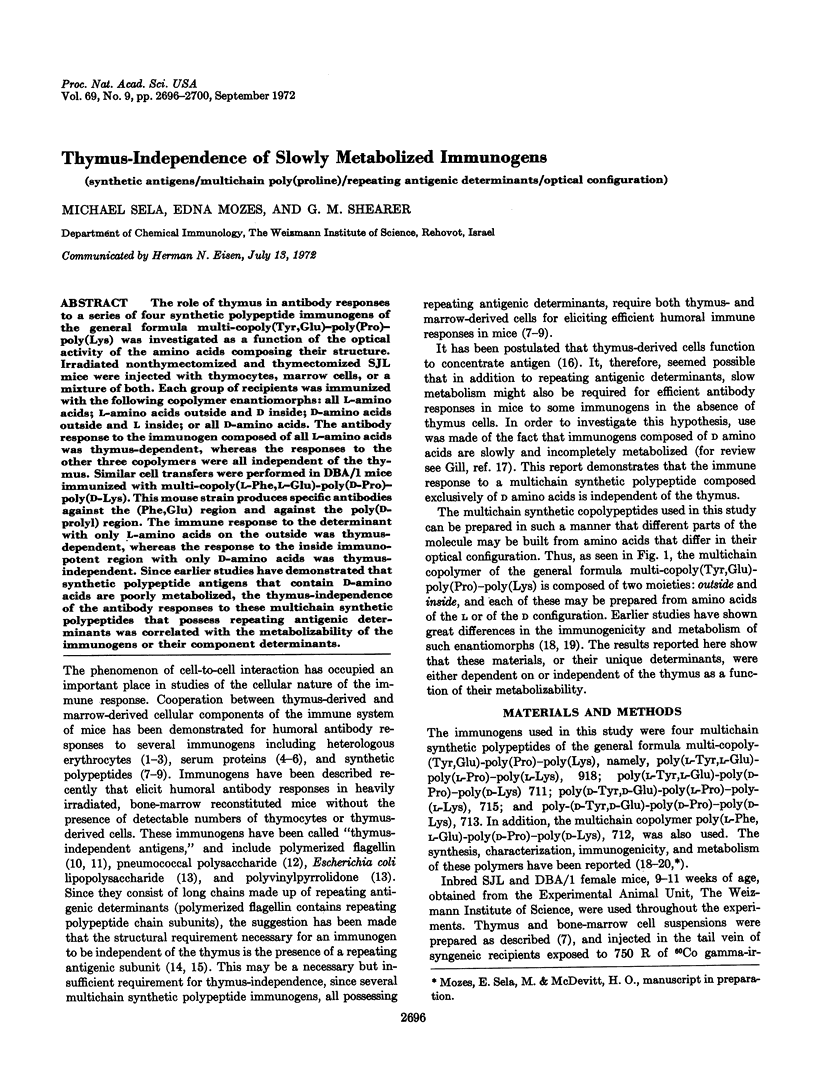
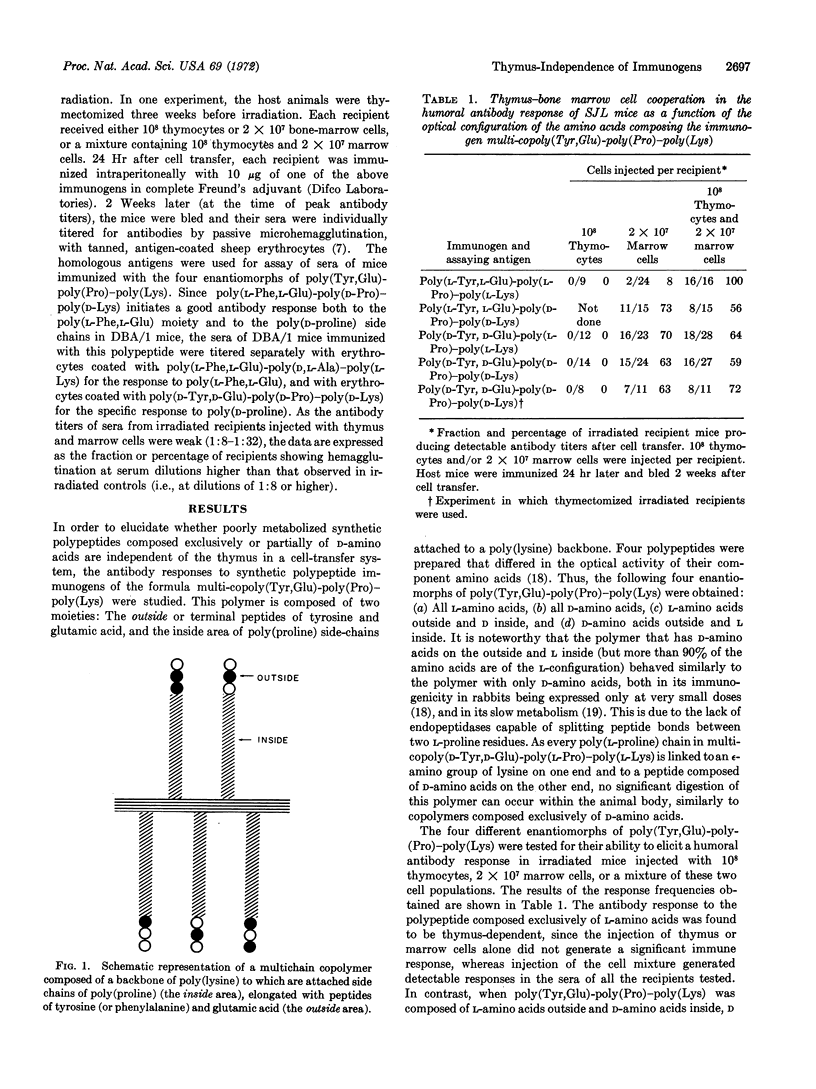
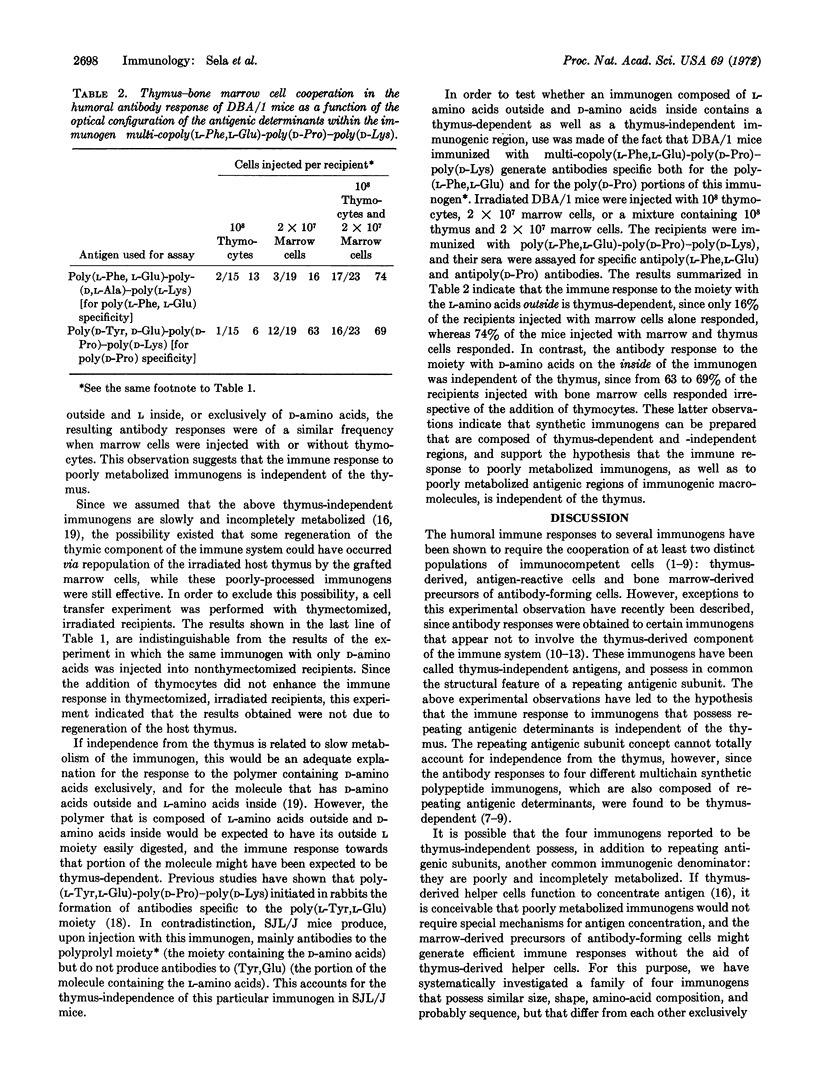
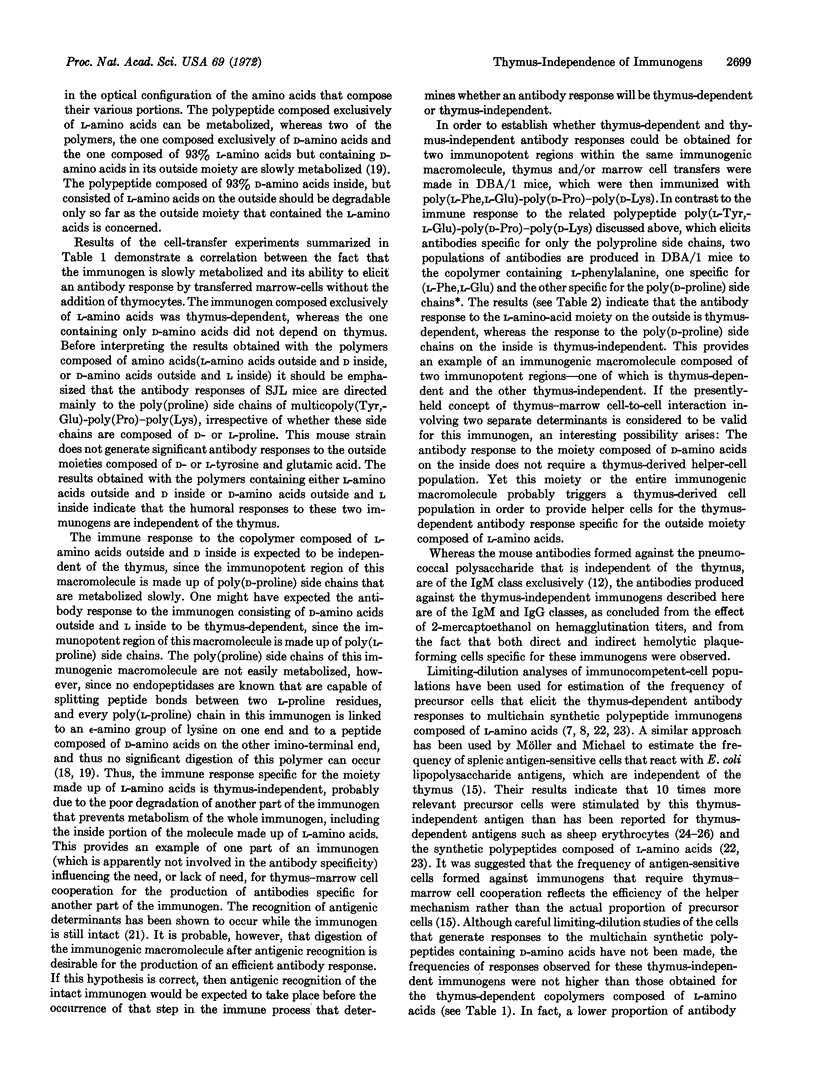
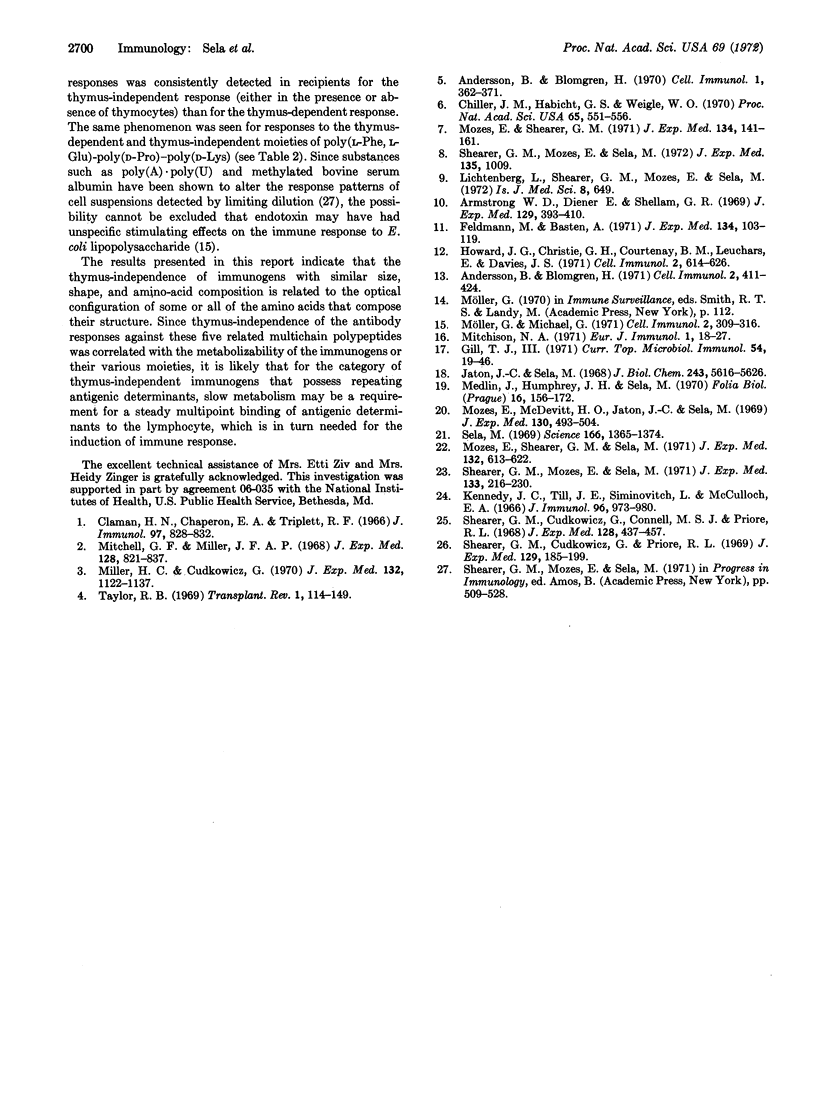
Selected References
These references are in PubMed. This may not be the complete list of references from this article.
- Andersson B., Blomgren H. Evidence for a small pool of immunocompetent cells in the mouse thymus. Its role in the humoral antibody response against sheep erythrocytes, bovine serum albumin, ovalbumin and the NIP determinant. Cell Immunol. 1970 Oct;1(4):362–371. doi: 10.1016/0008-8749(70)90014-6. [DOI] [PubMed] [Google Scholar]
- Andersson B., Blomgren H. Evidence for thymus-independent humoral antibody production in mice against polyvinylpyrrolidone and E. coli lipopolysaccharide. Cell Immunol. 1971 Oct;2(5):411–424. doi: 10.1016/0008-8749(71)90052-9. [DOI] [PubMed] [Google Scholar]
- Armstrong W. D., Diener E., Shellam G. R. Antigen-reactive cells in normal, immunized, and tolerant mice. J Exp Med. 1969 Feb 1;129(2):393–410. doi: 10.1084/jem.129.2.393. [DOI] [PMC free article] [PubMed] [Google Scholar]
- Chiller J. M., Habicht G. S., Weigle W. O. Cellular sites of immunologic unresponsiveness. Proc Natl Acad Sci U S A. 1970 Mar;65(3):551–556. doi: 10.1073/pnas.65.3.551. [DOI] [PMC free article] [PubMed] [Google Scholar]
- Claman H. N., Chaperon E. A., Triplett R. F. Immunocompetence of transferred thymus-marrow cell combinations. J Immunol. 1966 Dec;97(6):828–832. [PubMed] [Google Scholar]
- Feldmann M., Easten A. The relationship between antigenic structure and the requirement for thymus-derived cells in the immune response. J Exp Med. 1971 Jul 1;134(1):103–119. doi: 10.1084/jem.134.1.103. [DOI] [PMC free article] [PubMed] [Google Scholar]
- Gill T. J., 3rd Synthetic polypeptide metabolism. Curr Top Microbiol Immunol. 1971;54:19–46. doi: 10.1007/978-3-642-65123-6_2. [DOI] [PubMed] [Google Scholar]
- Howard J. G., Christie G. H., Courtenay B. M., Leuchars E., Davies A. J. Studies on immunological paralysis. VI. Thymic-independence of tolerance and immunity to type 3 pneumococcal polysaccharide. Cell Immunol. 1971 Dec;2(6):614–626. doi: 10.1016/0008-8749(71)90009-8. [DOI] [PubMed] [Google Scholar]
- Jaton J. C., Sela M. Role of optical configuration in the immunogenicity and specificity of synthetic antigens derived from multichain polyproline. J Biol Chem. 1968 Nov 10;243(21):5616–5626. [PubMed] [Google Scholar]
- Kennedy J. C., Till J. E., Siminovitch L., McCulloch E. A. The proliferative capacity of antigen-sensitive precursors of hemolytic plaque-forming cells. J Immunol. 1966 Jun;96(6):973–980. [PubMed] [Google Scholar]
- Medlín J., Humphrey J. H., Sela M. Studies on synthetic polypeptide antigens derived from multichain polyproline. II. Metabolism and localization. Folia Biol (Praha) 1970 Jun;16(3):156–172. [PubMed] [Google Scholar]
- Miller H. C., Cudkowicz G. Antigen-specific cells in mouse bone marrow. I. Lasting effects of priming on immunocyte production by transferred marrow. J Exp Med. 1970 Dec 1;132(6):1122–1137. doi: 10.1084/jem.132.6.1122. [DOI] [PMC free article] [PubMed] [Google Scholar]
- Mitchell G. F., Miller J. F. Cell to cell interaction in the immune response. II. The source of hemolysin-forming cells in irradiated mice given bone marrow and thymus or thoracic duct lymphocytes. J Exp Med. 1968 Oct 1;128(4):821–837. doi: 10.1084/jem.128.4.821. [DOI] [PMC free article] [PubMed] [Google Scholar]
- Mitchison N. A. The carrier effect in the secondary response to hapten-protein conjugates. II. Cellular cooperation. Eur J Immunol. 1971 Jan;1(1):18–27. doi: 10.1002/eji.1830010104. [DOI] [PubMed] [Google Scholar]
- Mozes E., McDevitt H. O., Jaton J. C., Sela M. The nature of the antigenic determinant in a genetic control of the antibody response. J Exp Med. 1969 Sep 1;130(3):493–504. doi: 10.1084/jem.130.3.493. [DOI] [PMC free article] [PubMed] [Google Scholar]
- Mozes E., Shearer G. M. Contribution of bone marrow cells and lack of expression of thymocytes in genetic controls of immune responses for two immunopotent regions within poly-(Phe,Glu)-poly-Pro--poly-Lys in inbred mouse strains. J Exp Med. 1971 Jul 1;134(1):141–161. doi: 10.1084/jem.134.1.141. [DOI] [PMC free article] [PubMed] [Google Scholar]
- Mozes E., Shearer G. M., Sela M. Cellular basis of the genetic control of immune responses to synthetic polypeptides. I. Differences in frequency of splenic precursor cells specific for a synthetic polypeptide derived from multichain polyproline ((T,G)-Pro--L) in high and low responder inbred mouse strains. J Exp Med. 1970 Oct 1;132(4):613–622. doi: 10.1084/jem.132.4.613. [DOI] [PMC free article] [PubMed] [Google Scholar]
- Möller G., Michael G. Frequency of antigen-sensitive cells to thymus-independent antigens. Cell Immunol. 1971 Aug;2(4):309–316. doi: 10.1016/0008-8749(71)90065-7. [DOI] [PubMed] [Google Scholar]
- Sela M. Antigenicity: some molecular aspects. Science. 1969 Dec 12;166(3911):1365–1374. doi: 10.1126/science.166.3911.1365. [DOI] [PubMed] [Google Scholar]
- Shearer G. M., Cudkowicz G., Connell M. S., Priore R. L. Cellular differentiation of the immune system of mice. I. Separate splenic antigen-sensitive units for different types of anti-sheep antibody-forming cells. J Exp Med. 1968 Sep 1;128(3):437–457. doi: 10.1084/jem.128.3.437. [DOI] [PMC free article] [PubMed] [Google Scholar]
- Shearer G. M., Cudkowicz G., Priore R. L. Cellular differentiation of the immune system of mice. II. Frequency of unipotent splenic antigen-sensitive units after immunization with sheep erythrocytes. J Exp Med. 1969 Jan 1;129(1):185–199. doi: 10.1084/jem.129.1.185. [DOI] [PMC free article] [PubMed] [Google Scholar]
- Shearer G. M., Mozes E., Sela M. Cellular basis of the genetic control of immune responses to synthetic polypeptides. II. Frequency of immunocompetent precursors specific for two distinct regions within (Phe, G)-Pro--L, a synthetic polypeptide derived from multichain polyproline, in inbred mouse strains. J Exp Med. 1971 Feb 1;133(2):216–230. doi: 10.1084/jem.133.2.216. [DOI] [PMC free article] [PubMed] [Google Scholar]
- Shearer G. M., Mozes E., Sela M. Contribution of different cell types to the genetic control of immune responses as a function of the chemical nature of the polymeric side chains (poly-L-prolyl and poly-DL-alanyl) of synthetic immunogens. J Exp Med. 1972 May 1;135(5):1009–1027. doi: 10.1084/jem.135.5.1009. [DOI] [PMC free article] [PubMed] [Google Scholar]
- Taylor R. B. Cellular cooperation in the antibody response of mice to two serum albumins: specific function of thymus cells. Transplant Rev. 1969;1:114–149. doi: 10.1111/j.1600-065x.1969.tb00138.x. [DOI] [PubMed] [Google Scholar]


